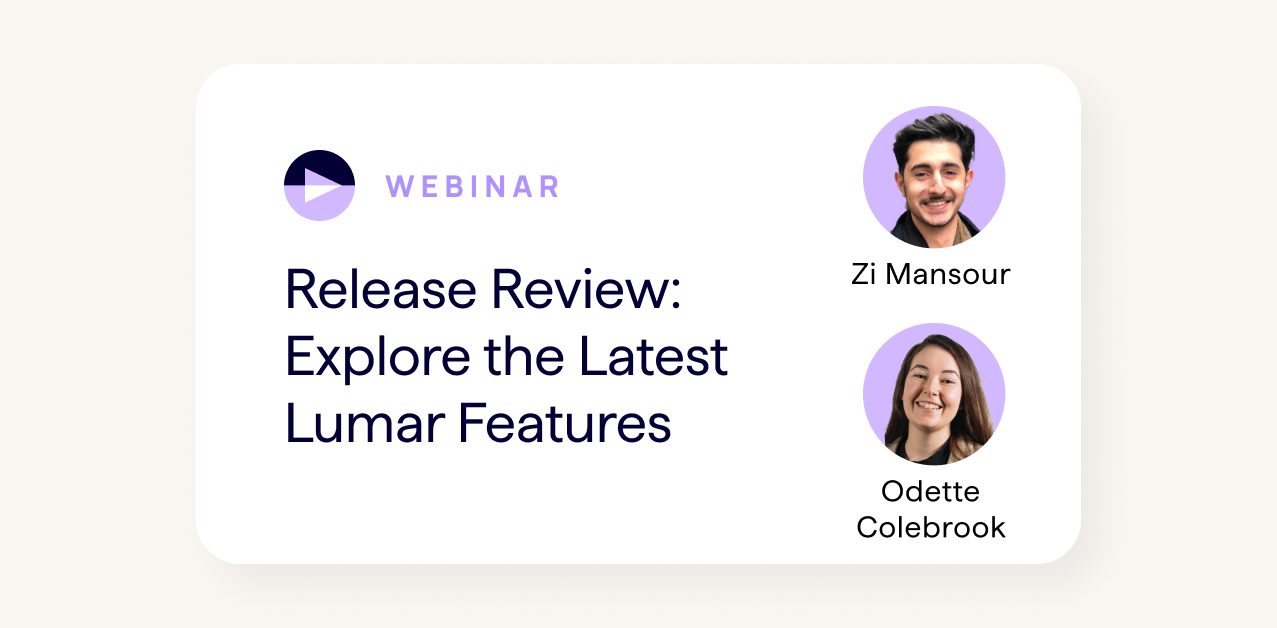Website pros and SEOs— are you feeling limited by the built-in metrics on your website analytics platform? Do you wish you could easily get the exact information you’re looking for, about any area of your website, with no time-consuming manual spreadsheets involved?
Learn how to build fully customized website analytics for fast, easy reporting on just about any website data you can imagine in this on-demand webinar.
With an advanced website crawler like Lumar, you can easily extract and report on any website data you’d like — and build tailored analytics solutions for your most unique use cases. Our expert speakers will show you how to create and use custom website metrics in this Solutions Showcase webinar.
Join Lumar CEO Panos Savoupolos and Head of Professional Services Richard Barrett for this introduction to the hows and whys of building custom website analytics for easier, bespoke reporting on just about any website data you can imagine.
Watch the full webinar session above (including Q&A session and audience polls), or read on for our key takeaways.
The data you need to optimize your website
Every website is unique. And the data you’ll need to optimize your site for peak commercial performance will depend on your unique use cases and busiess needs.
SEO, site speed, and web accessibility data are great baselines to get started with website optimization — but what if you need to answer more bespoke questions about your website and how it performs?
Rather than relying on time-consuming manual exports of data from different sources and manual analysis in spreadsheets, building fully customized website analytics in a single platform can save your team significant time and effort.
With Lumar, it’s never been easier to analyze and report on website data — our custom website metrics offering is paving the way for a new era in web analytics.

Custom Web Analytics: Going beyond standard analysis
All websites generate data. However, what is useful website data for a financial services company will be notably different from, say, the actionable data a B2C e-commerce website (or a news publisher or a travel website) needs to maximize its potential.
So, how do you identify and incorporate the unique data you need into your operational workflows?
Getting the right website crawler in place is a crucial first step—you’ll need a crawler that is fast and flexible enough to handle your unique data use cases.
Around two years ago, Lumar began expanding its platform beyond its core SEO analytics, adding out-of-the-box solutions for website speed and web accessibility analysis. Now, Lumar has expanded its offering to include custom website metrics alongside these core data offerings.
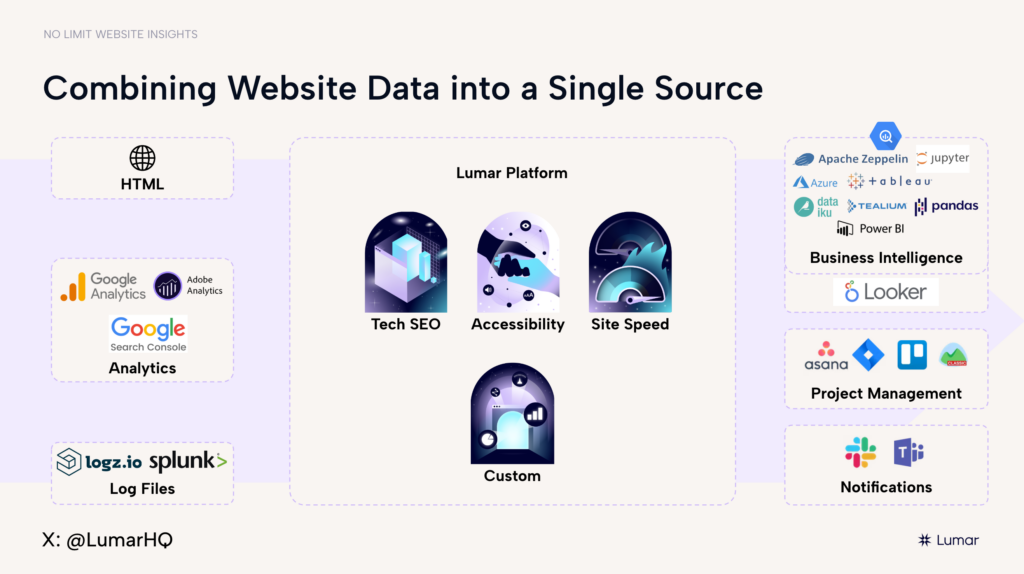
“This capability gives Lumar customers the opportunity to access SEO and non-SEO data such as site speed and accessibility,” Savopoulos says. “But it also gives them the opportunity to capture any data from the HTML of the page and create custom analysis and insights for action.”
There are three broad categories for custom website analytics:
- Static Analytics: Report on practically any information on the page.
- Dynamic Analytics: Replicate human behavior to analyze, understand, and optimize user interactions with your website.
- Advanced Analytics: Integrate and compare external data sources and utilize AI to get deeper insights and tailored suggestions for optimizing your site.
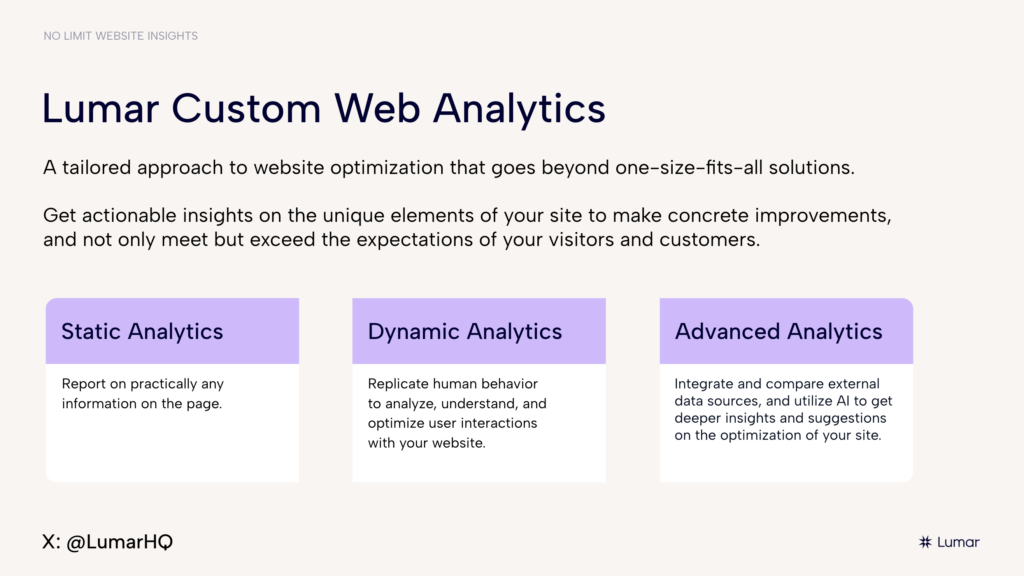
The starting point for custom analytics in Lumar is our crawler. Every Lumar user can easily access broad website health data. Simply configure your crawl settings and set up projects in Lumar, and you’ll have access to SEO, site speed, and accessibility analytics off the shelf from our platform and APIs.
Additionally, our crawler is able to incorporate organizational logic or insights into operational questions. For instance, which types of pages on your website lead to the most search results?
Savopoulos notes that all of these data sets—whether off-the-shelf metrics like SEO, accessibility, and site speed or broader organizational data unique to your analysis use cases—feed into your website reporting and operational workflows to provide actionable insights centralized within the platform and portable to any data repository.
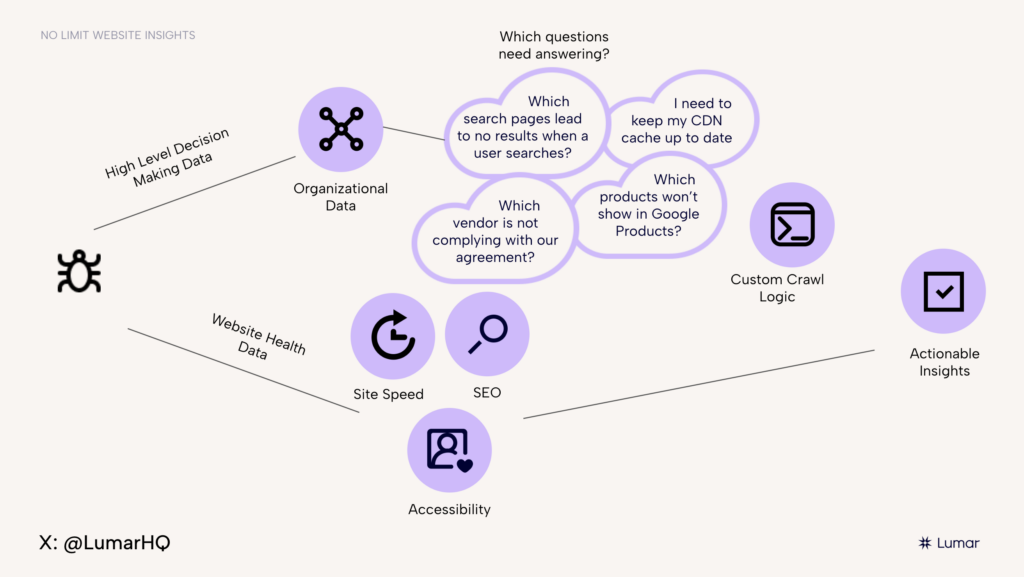
But what exactly can be done with more bespoke website metrics and analytics? Let’s dive into some examples…
Custom website analytics for retail websites: price comparison reporting
Savopoulos notes that, for retailers, understanding your competitor’s product pricing is very important. But, automating this identification and data capture at scale is challenging.
With Lumar custom metrics in place, you can easily compare data from different websites to understand how your inventory is priced relative to your competitors. This can then inform your pricing strategy, website optimization priorities, or the decision to run specific sales and promotions on items where your competitors may be undercutting you on price.
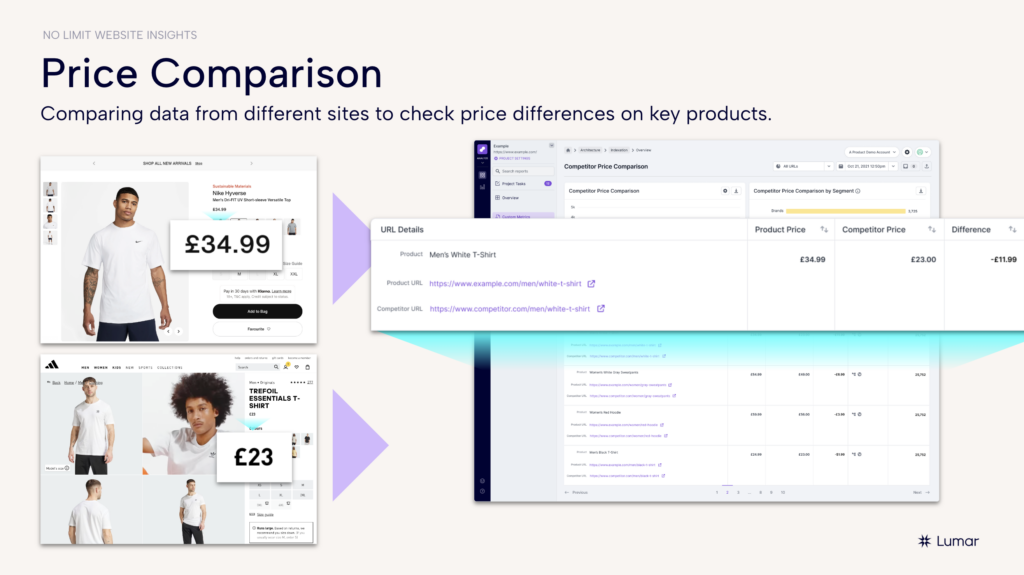
Richard Barrett notes that streamlining and automating this sort of custom data collection can help retail website teams stay on the front foot and beat their competition online. You can even begin to make decisions during the crawl, which is useful for large e-commerce sites with pages running into the millions and where full website crawls may take hours to complete.
“You’re not having to wait for the crawl to complete,” he says. “You can [access the initial data and] start to have that thinking done while the crawl is ongoing. Maybe even export and ping out, say, ‘well, our competitors just started a sale; should we react?’”
Custom website analytics for publishers: track time between publication and indexing
Content creation and curation are notoriously time-consuming efforts for any website team. With that in mind, Savopoulos highlights that normally, whoever gets Google to index first wins. This is especially important for time-sensitive publishers like new media websites.
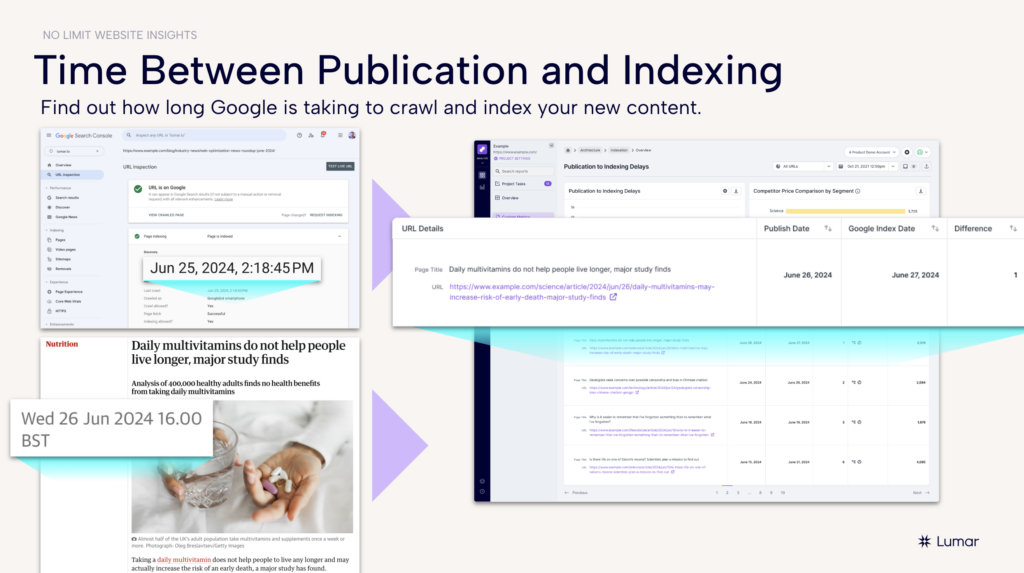
Lumar’s custom metrics give content-focused website teams (like SEOs for news publishers) the ability to understand how long it takes Google to access and index your new content.
Barrett adds that there are a few things we can investigate here: Why did Google not index your latest article, and when did Google choose to index your page?
“And we can output that back out,” he says. “Then we can blend that with other data sources. How much traffic did you actually get? Was that valuable? When did the traffic spike stop?”
Whether it is news content that drops off sharply or more evergreen content, it is useful to be able to pinpoint exactly when an article loses its value for your site.
Custom analytics for keyword optimization
Every organization that engages with SEO has a keyword strategy. The Lumar platform aims to create bespoke opportunities to expand keyword optimization using large language models, easily accessible keyword recommendations, and dynamic content scores based on the keywords’ presence in page elements (e.g., title, meta description, H1 tags, etc.).
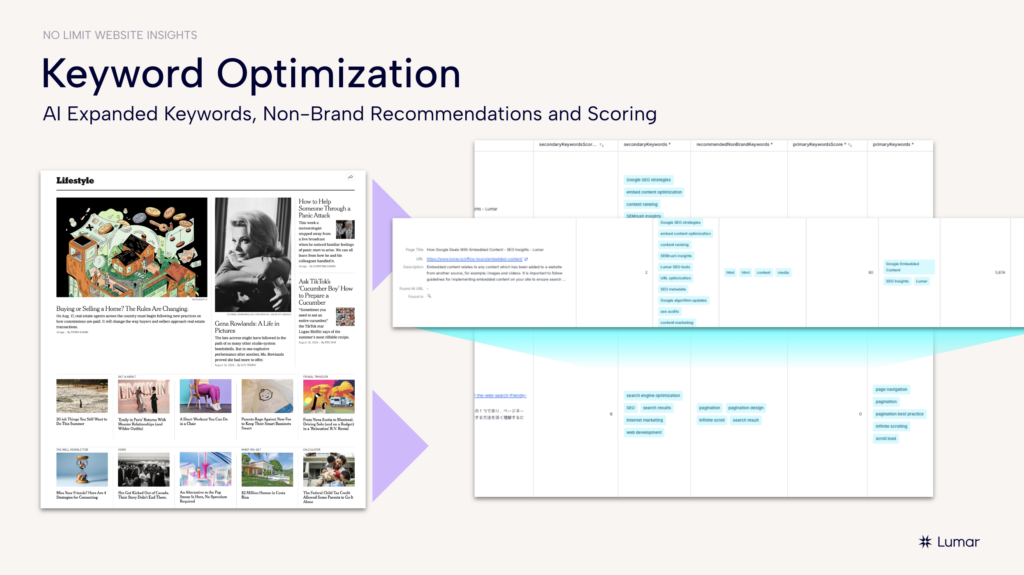
For Barrett, one of the most powerful things about using large language models for keyword optimization is being able to take a very big data set and summarizing it.
In terms of keywords, we can quickly ascertain what is being referenced most often across thousands and millions of pages. What are the key topics? Are they what you know them to be, or are they unexpected? We can then increase of decrease the use of these keywords to reduce keyword cannibalization.
More example use cases for custom web analytics
When it comes to building custom website analytics, the possibilities are nearly endless.
Below, we’ll dive into some examples in more depth, but as a starting point, here is an overview of some example use cases for custom analytics:
E-Commerce – Custom Web Analytics Examples:
- Checking product stock availability
- Evaluating internal search and product recommendations to ensure relevance
- Monitoring vendor product rankings to ensure compliance with agreements
- Tracking regional commercial messages to ensure suitability
- Compare PDP product schema to product feed and highlight differences to team
- Automate updates to product feeds
- Competitor price comparison
Publishing & Content – Custom Web Analytics Examples:
- Managing content quality issues on UGC sites such as tracking errors from embedded videos
- In-depth internationalization assessments to improve global performance
- Analyzing keywords and sentiment from articles
- Content analysis to identify and fill topic gaps
Paid Media – Custom Web Analytics Examples:
- Get up-to-date product stock information to avoid wasting PPC budget on out of stock pages
- Identify changes to PPC landing pages that affect conversion performance (and revenue)
Website Compliance – Custom Web Analytics Examples:
- Custom compliance or security verifications
- Tracking cookies to ensure compliance with data protection regulations
Website Performance – Custom Web Analytics Examples:
- Monitoring CDN errors for actionable insights
- Updating CSN caches to enhance site reliability
- Identifying large images or scripts to reduce data transfer
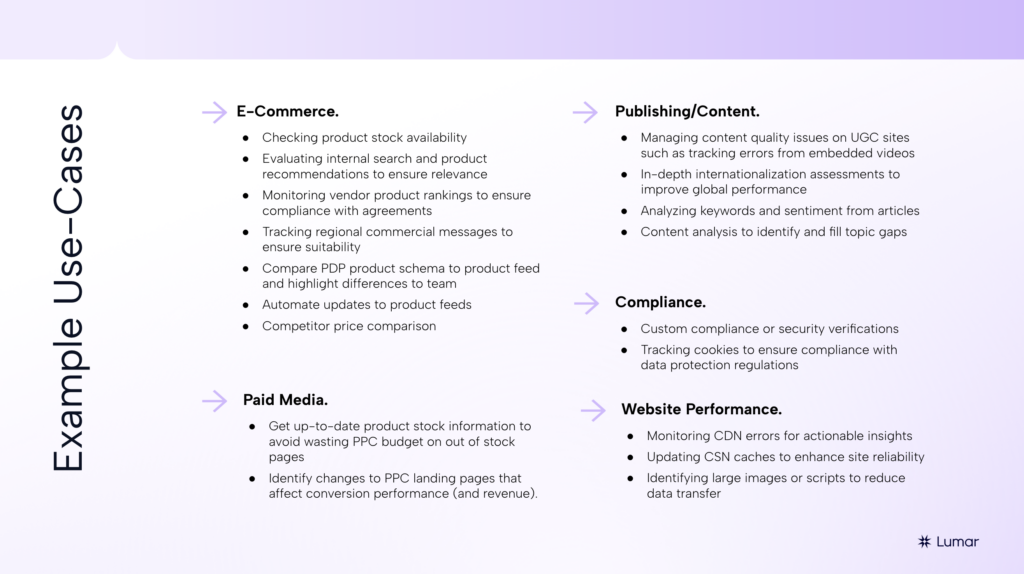
Now, let’s look at a few of these examples in more detail…
Capture soft 404s before Google finds them
Barrett points out that soft 404 pages are often identifiable by specific words used on a page, such as:
- “Sorry, there are no results”
- “This item is out of stock”
The goal in building custom metrics to identify these pages is to find pages on your site that deliver a ‘soft 404’ and will likely be dropped from the search engine index before these pages lose their value.
By using Lumar’s custom analytics, you can do this at scale (quickly and in multiple languages) without having to constantly update regex or code.
“We can redirect that page,” Barrett adds, “maybe save some of those signals, or maybe we realize [there is a soft 404 in place] and we populate that page with content. Or we just get rid of it.”
“We take the decision [of how to handle soft 404 pages] out of Google’s hands, put it back into ours.”
Capture autocomplete text/image suggestions from internal site search tools
Here is an example dealing with user interactions on your website rather than content.
Autocomplete suggestions with products and text are extremely useful to fill in gaps.
But are the auto-complete suggestions on your site correct? Are they in the order that you want? Or are they showing products that you don’t want to promote?
The goal here is to increase the conversion rate from your internal site search tools. Building custom metrics to analyze your internal site search suggestions can help you optimize your site search autocomplete so it does exactly what you want it to do.
Identify traffic-driving keywords & get new suggestions based on content
Returning to the all-important topic of keyword optimization, Barrett points out that Lumar can identify the page keywords that drive traffic to your site via Google.
From here, you can identify keyword overlaps to pinpoint keyword cannibalization issues and then use the AI-powered keyword generation tool to find potential opportunities based on your existing content with a view to increasing impressions and clicks – at scale.
Capture website rendering errors
The goal in this custom metrics example, Barrett says, is to find and fix website content rendering issues so they don’t impact your ranking or UX.
We can use custom metrics in Lumar to find and capture errors on execution. We can track external failed calls such as CDNs returning a 404. And we can record the full error execution message and what happens when it fails.
Summary: Why use custom web analytics?
In closing, Savopoulos sums up the value of building custom analytics for your website:
- Increase Conversions and Revenue. Go beyond standard analysis to ensure every part of your site performs.
- Increase Responsiveness. Take swift action to fix vital parts of your website when new issues arise.
- Increase Competitiveness. Gain a real competitive edge with unique user flows that exceed visitor expectations.

Meet the Webinar Speakers
- Panos Savopoulos, CEO, Lumar
- Richard Barrett, Director of Professional Services, Lumar
- Andrew Levey, Head of Product Marketing, Lumar
Don’t miss the next Lumar webinar!
Sign up for our newsletter below to get alerted about upcoming webinars, or give us a follow on LinkedIn or Twitter/X to stay up-to-date with all the latest news in website optimization.
Want even more on-demand SEO webinars? Explore the full library of Lumar SEO webinar content.





